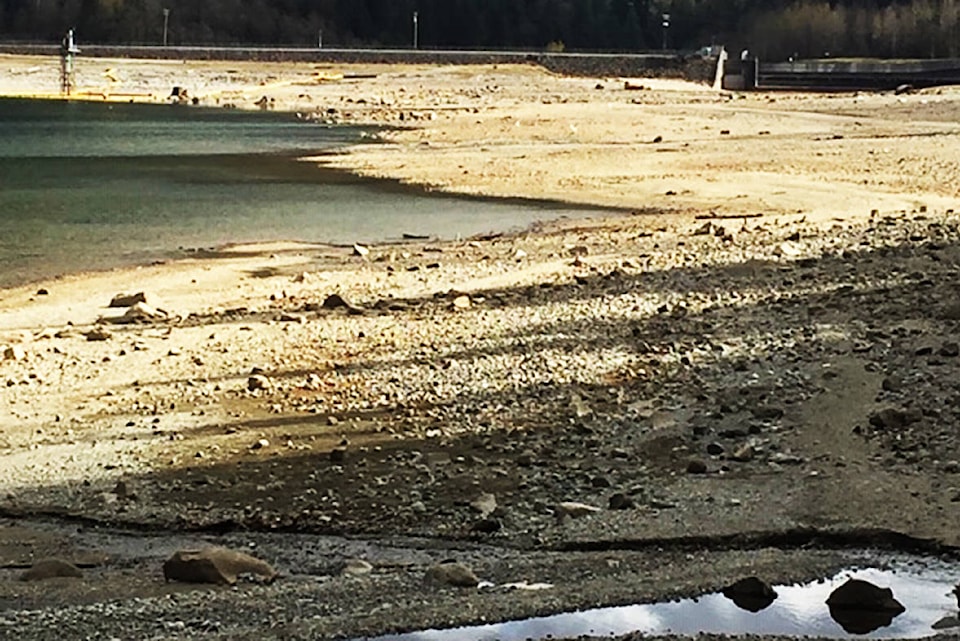… They would not listen. They did not know how. Perhaps they’ll listen now. Starry, Starry Night – singer Don McLean.
On March 31, Maple Ridge Coun. Gordy Robson checked B.C. Hydro’s water-levels graph for the Alouette Lake reservoir.
What he discovered made him angry and frustrated.
“B.C. Hydro had drawn the level down to 116.4 metres, far below what sockeye need to migrate over the dam into the river. Hydro should never have allowed that.”
Geoff Clayton is a past president of ARMS and elder historian. Robson emailed him to see if he was overlooking anything.
“Not a thing,” Clayton replied.
He couldn’t remember a spring when the lake was drawn down so low.
The reservoir was to be at 121.85 m at the dam’s spill gate by April 15 so kokanee, or sockeye can get to the ocean. This means there’s a hole in the annual returns cycle.
B.C. Corrections and ARMS have a program to move returning adults by truck to the reservoir. But in 2021, Clayton said, probably none will come back.
Low water causes concerns.
“The loss of rock algae – fish food – is another impact. Exposed, it will die. The volume of water leaving the dam has been reduced, so a third of river flow is gone.”
As of April 15, B.C. Hydro was to have a reservoir level of 121.85 m for kokanee and 122.5 for people to use the beaches and boat launch by May 15.
“Now, it gets worse. The minimum flow pipe has a trash rack,” Clayton said. “It’s cleared of woody debris in the spring, when the smolts are getting their dam-gate surface release flow and the pipe’s valve is closed. The rack debris has built up. Smolts are swirled into a high-velocity vortex into the ‘rack of death.’”
How could this happen?
Clayton said March was one of the driest on record.
High electricity demand due to record-cold temperatures in February, and a dry that month and in March resulted in low water levels at the Alouette Lake reservoir, and others, said Kevin Aquino, with B.C. Hydro.
He added that Hydro will continue to monitor inflows and water levels, which are expected to improve in the next week with increased precipitation and the onset of the spring freshet.
However, Clayton added, Hydro has a climate forecasting centre. It has a climatologist on staff. Hydro should be asked to release records of the Alouette reservoir inflows and outflows through the tunnel into the Stave going back to Jan 1.
Robson thinks Hydro doesn’t want salmonids in the reservoir.
Clayton said minimum base flows came into force in 1971. In 1985, he said he did a flow-records search to see if they were being met and found, from 1971 to 1985, only two of the 14 years showed B.C. Hydro had met its agreement.
“In a 2006 Water Use Plan, I made a point that the reservoir shouldn’t be drawn down lower than 119 m.”
Clayton told me that the “normal operating level” needs to be 119 m when kokanee are trying to migrate to the ocean. That’s a short period of time, from April 15 to mid-May.
Clayton said the fight for “a reasonable amount of base river flow” with other water licence holders is a long one.
In 1923, the B.C. Electric Railway, he said, owned the rights.
The rail company was not interested in minimum flows for human health, or fish, even though they were recommended by the federal government, Clayton added.
In 1969, Clayton asked the DFO why it wasn’t fighting for base flows?
Clayton said he was told, “if we make this request of B.C. Hydro, they will charge us with the loss of generation capacity.”
More history.
“In 1970, Hydro couldn’t get water through its minimum level flow pipe. It was plugged. I screamed from the rooftops,” Clayton said. “That finally led to discussions with Hydro, the province, and DFO over what was a reasonable flow. DFO finally agreed on 0.25 per cent of the average inflows coming into the lake before the dam was built. We said dropping a river below 30 per cent would result in a non-sustainable aquatic environment. They weren’t listening.”
Clayton wants a better B.C. Hydro management plan for reservoir draw-downs, and a new minimum flow pipe to the river.
“The one we have kills baby fish.”
He wants a “scientific” count of sockeye entrained in the diversion tunnel, and a plan to end it.
“We need Hydro at the table to recognize these public demands.”
Robson wants a reservoir management plan that “guarantees the health and safety of people. I want my grandchildren to be able to see the salmon thrive in Alouette Lake reservoir.”
• See related story on page 7.
Jack Emberly is a retired teacher, local
author and environmentalist.
